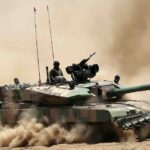
Despite the bonhomie between the United States and India, the geopolitical constraints of New Delhi remain visible
By Vikas Gupta
Defence News of India, July 7, 23
As Prime Minister Narendra Modi wraps up his visit to France on July 14e, he will have had two busy weeks juggling competing priorities. Mr. Modi’s travels began on June 21 with a three-day state visit to the United States, including meetings in New York with American business leaders; then continued to Washington DC for ceremonies. On his way back, India’s prime minister paid a state visit to Egypt on June 24-25, a much-needed reaffirmation of ties with a regional power. He then took part in a virtual summit of the Shanghai Cooperation Organization (SCO) on July 4, in the presence of the leaders of aAll SCO member states viz. China, Russia, Kazakhstan, Kyrgyzstan, Pakistan, Tajikistan and Uzbekistan. Now, after a brief stopover in New Delhi, Mr Modi will travel to France on July 13-14.
The last time Mr. Modi visited France was in April 2015. A few days before he embarked for Paris, a small part of the Indian media published “scoops” announcing a intergovernmental acquisition of 36 Rafale fighters for the Indian Air Force (IAF). As expected, Modi and French President Francois Hollande announced the controversial sale of 36 Rafales for 7.8 billion euros. India’s opposition parties were quick to accuse the government of a twisted deal.
As Modi prepares to visit Paris again, there are echoes of a similar outcry. The usual suspects in the Indian media have announced that the French government – now one of India’s closest strategic and military-industrial partners – has authorized French engine manufacturer Safran (formerly Snecma) to design, develop, test , jointly manufacture and certify an engine to power India’s futuristic fifth-generation Advanced Medium Combat Aircraft (AMCA).
There will inevitably be controversy if Safran is arbitrarily “designated” as a development partner to co-develop an Indo-French engine for the AMCA. It would be impossible to bulldoze such a contract on a sole-source basis, as the British company Rolls-Royce has already thrown its hat in the ring and offered to partner with the Defense R&D Organization (DRDO) to design and develop an engine for the AMCA. The IAF is watching these developments closely, as the AMCA is expected to form the backbone of the IAF’s fifth generation fighter fleet in about a decade.
Meanwhile, the Indian Ministry of Defense (MoD) has already committed to using US-made General Electric (GE) engines for the Tejas fighter. The Tejas Mark 1 and 1A, a fleet of 123 fighter jets, will be powered by GE F-404IN engines. The IAF has already signed a Rs 5,375 crore contract with GE for 99 F-404IN engines.
The more powerful GE F-414 engine, which powers the Swedish Gripen E fighter, will also power the Tejas Mark 2. The contract between GE and Hindustan Aeronautics Ltd (HAL) to build the F-414-INS6 in India was signed in during the visit to America and which was noted in the joint statement issued at the end of the meeting.
General Electric motors for India
|
|
F-404-IN20 |
F-414-INS6 |
F-414 Improved |
|
|
|
|
|
|
Plane |
Tejas Mark1 & 1A |
Tejas Mark 2 |
Tejas Mark 2 and AMCA |
|
Dip* |
84 kN |
98kN |
116kN |
|
Length |
391cm |
391cm |
391cm |
|
Air flow |
70kg/s |
77.1kg/s |
85kg/s |
|
Max diameter |
89cm |
89cm |
89cm |
|
Inlet diameter |
71cm |
79cm |
79cm |
|
Pressure ratio |
28:1 |
30:1 |
30:1 |
(Source: General Electric official website)
* kiloNewtons, or kN
With two GE engine types from the same family already powering two Tejas fighter variants (Mark 1, Mark 1A and Mark 2), it would make sense for more advanced Tejas fighter variants to opt for more advanced engine variants. A logical choice would be the more powerful F-414 upgraded engine, which incorporates additional technical advances that can be adapted to the F-414. This would provide better component capacity, leading to reductions in cost of ownership or a 20% increase in thrust with improved specific fuel consumption and improved reliability. This option is being considered for the US Navy’s F/A-18E/F Super Hornet and EA-18G Growler fleet, which operates from the US Navy’s 11 super carriers.
One of the major obstacles to US-India high-tech cooperation has been the capacity differential, with the Indian side having only a limited menu of offerings. However, this time both sides thought beyond simply co-developing or co-manufacturing defense and strategic equipment. Saying that technology will be instrumental in deepening the US-India partnership, Modi and President Joe Biden called the Initiative on Critical and Emerging Technologies (iCET), signed in January 2023, a major milestone. in Indo-American relations. They renewed the United States and India’s commitment to an open, accessible, and secure technology ecosystem.
Having discovered the limits of India in the co-development of defense equipment, MM. Modi and Biden have paved the way for space cooperation, in which the United States has so far played a limited role. India can offer a tradition of ‘frugal engineering’ of spacecraft and satellites.Welcoming the decision of the National Aeronautical and Space Administration (NASA) and the Indian Space Research Organization (ISRO) to develop a strategic framework for human spaceflight cooperation by the end of 2023, MM. Modi and Biden welcomed NASA’s announcement to provide advanced training for Indian astronauts at the Johnson Space Center in Houston, Texas, with the aim of mounting a joint effort to the International Space Station in 2024.
Ambassador Alexander Kadakin, Moscow’s emissary to New Delhi for 12 years, liked to tell an anecdote about Indo-Russian space cooperation. As a young diplomat, while visiting an Indian space facility in Hyderabad, he was surprised to hear snippets of conversations between Indian scientists – all of which were in the Russian language. Inquiring from the Indians, he learned that most of them had been trained in Russia and that their lingua franca was Russian. More tellingly, when New Delhi wanted to make a statement by sending an Indian astronaut into space, it was Russia that held India in its hand throughout the long process that culminated in the commander of Rakesh Sharma became India’s first astronaut in 1984.
Now that India’s expertise has grown, MM. Modi and Biden hailed India’s Space Policy – 2023 and called for enhanced business collaboration between the private sectors of the two countries across the space economy value chain and addressing controls at the export and facilitate technology transfer.
Despite the American-Indian bonhomie, the geopolitical constraints of New Delhi remain visible. At the SCO Virtual Summit on July 4e, Russian President Vladimir Putin, Chinese supremo Xi Jinping and Mr Modi found little common ground, each of them focusing on their own immediate goals rather than a united front. Mr Putin, shaken by his setbacks in Ukraine, including the revolt of the Wagnerian mercenary militia, insisted that his campaign in Ukraine had international support. Mr Xi, seeing an opportunity to castigate the United States, called for an end to “hegemonism” and “power politics”. Mr Modi, who was hosting the virtual meeting, chose to hit out at arch-rival Pakistan by calling on the global community to unite in a “fight against terrorism”. Unfortunately, Mr Modi chose not to say a word about China’s military occupation of chunks of Indian territory in Ladakh.






